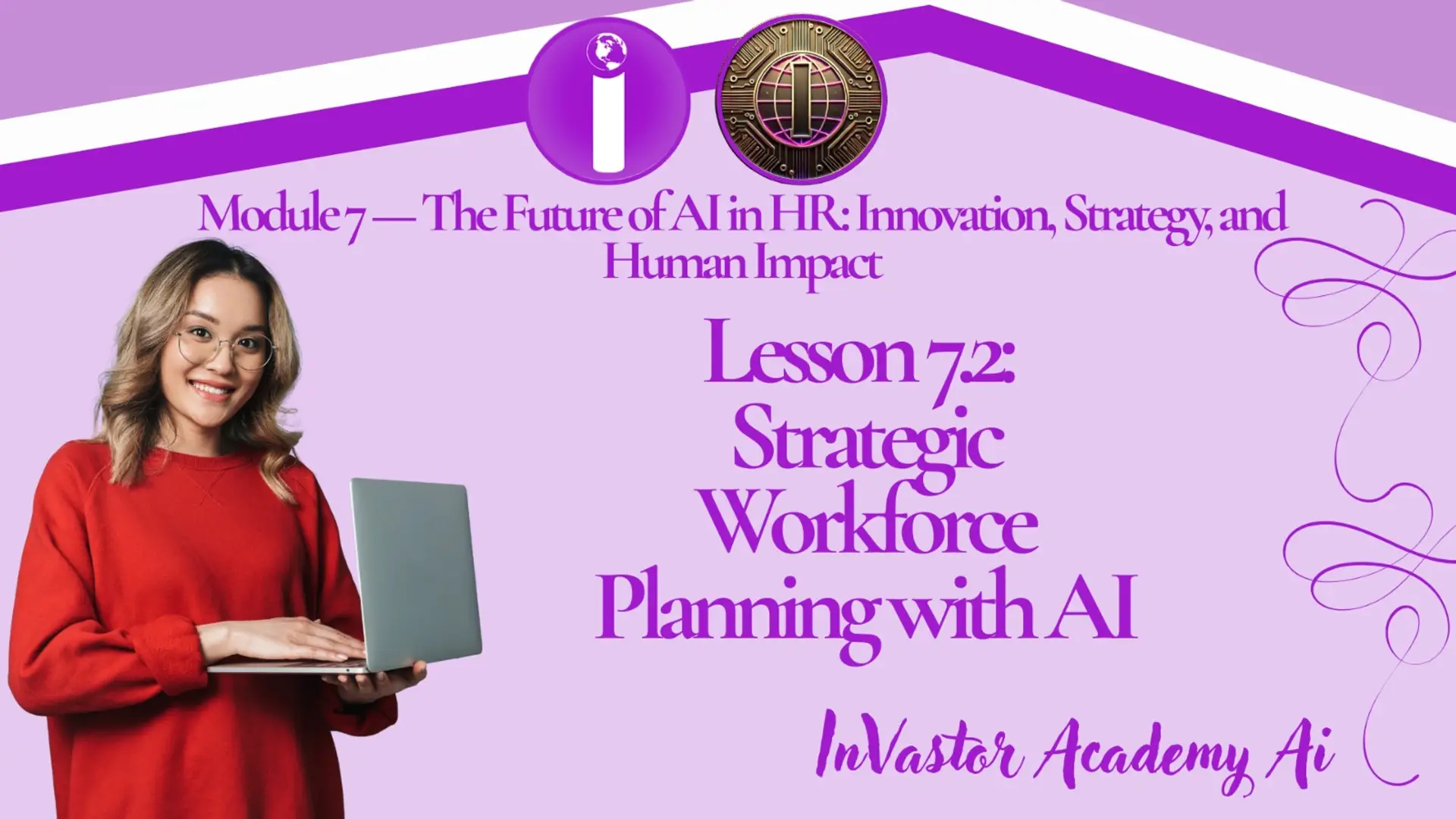

Lesson 7.2 — Strategic Workforce Planning with AI
Module 7 — The Future of AI in HR: Innovation, Strategy, and Human Impact
Lesson 7.2 — Strategic Workforce Planning with AI
Learning Objectives
By the end of this lesson, learners will be able to:
- Understand the role of AI in workforce planning and organizational strategy.
- Analyze how predictive analytics supports talent forecasting and gap analysis.
- Identify AI tools and techniques for optimizing workforce deployment.
- Evaluate the benefits and risks of AI-driven workforce planning.
- Apply AI insights to enhance decision-making in talent management and business strategy.
1️⃣ Introduction: The Role of AI in Workforce Planning
Strategic workforce planning ensures that organizations have the right people, in the right roles, at the right time.
AI enables HR to move from reactive planning to predictive, data-driven decision-making, aligning workforce capabilities with organizational goals.
Example:
A technology company uses AI to forecast talent needs for emerging projects, identifying gaps in skills before critical deadlines.
💡 AI helps HR anticipate workforce changes instead of simply responding to them.
2️⃣ How AI Supports Strategic Workforce Planning
AI Function Description HR Application Example
Predictive Analytics Forecasts talent demand and supply trends Anticipating turnover, hiring needs, and succession requirements Workday Talent Insights predicting future staffing needs
Skills Mapping Identifies current employee capabilities vs. organizational requirements Internal mobility and reskilling initiatives Eightfold.ai mapping skills for future roles
Scenario Planning Simulates workforce scenarios under different business conditions Preparing for mergers, expansions, or downsizing IBM HR Analytics simulating staffing impacts
Talent Gap Analysis Pinpoints skill shortages and overcapacity Aligning recruitment and learning programs Gloat AI identifying skill gaps for leadership pipelines
Workforce Optimization Matches employees to roles or projects efficiently Resource allocation and project staffing Fuel50 AI suggesting best-fit internal talent
3️⃣ Benefits of AI in Workforce Planning
- ✅ Proactive Decision-Making: Predicts staffing needs before gaps occur.
- ✅ Cost Efficiency: Reduces overstaffing or costly recruitment delays.
- ✅ Enhanced Talent Mobility: Identifies internal candidates for new opportunities.
- ✅ Strategic Alignment: Ensures workforce capacity aligns with organizational goals.
- ✅ Data-Driven Insights: Removes guesswork from workforce management.
Example:
PepsiCo leverages AI to anticipate leadership gaps and plan succession programs ahead of time, maintaining continuity and reducing talent risk.
4️⃣ Key AI Tools and Techniques
Workday Talent Insights: Provides predictive workforce analytics and succession planning.
Eightfold.ai: Uses AI to map employee skills, career paths, and internal mobility.
Visier Workforce Planning: Integrates data from multiple sources to forecast workforce demand.
Gloat AI: Matches employees to projects, learning, and development opportunities.
IBM Talent Frameworks & Analytics: Uses predictive modeling to assess workforce trends and gaps.
💡 Tip: Choose tools that integrate seamlessly with HRIS systems and provide actionable insights, not just reports.
5️⃣ Limitations and Considerations
Limitation Description Mitigation
Data Quality Issues Inaccurate or incomplete HR data can reduce predictive accuracy Clean and standardize data before AI use
Bias in Predictions AI may perpetuate historical workforce biases Audit algorithms regularly and ensure diversity in training data
Over-Reliance on AI Managers may ignore human judgment Maintain a “human-in-the-loop” approach
Change Management Challenges Employees may resist AI-driven workforce decisions Communicate purpose, benefits, and transparency
6️⃣ Real-World Applications
- Unilever: Uses AI for workforce scenario modeling to anticipate talent needs in different business units.
- Microsoft: Employs predictive analytics to forecast turnover and skill requirements for key roles.
- IBM: Simulates workforce changes during restructuring, ensuring minimal disruption.
- Deloitte: Applies AI to align staffing with client projects and internal capacity planning.
Example:
AI can identify emerging skills gaps in real-time, allowing HR to upskill or redeploy employees proactively, rather than hiring externally.
7️⃣ Practical Activity
Task:
Design a Strategic AI-Driven Workforce Plan for your organization or department:
- Identify current workforce composition and key roles.
- Use AI tools (real or hypothetical) to forecast talent needs and potential gaps.
- Recommend internal mobility, reskilling, or recruitment strategies.
- Identify risks and mitigation strategies (bias, data quality, employee trust).
8️⃣ Supplementary Resources
- 🎥 “AI for Workforce Planning and Talent Management” — SHRM Learning Series
- 🎥 “Predictive HR Analytics for Strategic Decision-Making” — Deloitte Insights
- 🎥 “Optimizing Workforce Planning with AI” — Harvard Business Review
- 🎥 “AI-Driven Talent Mobility” — McKinsey & Company
Lesson Quiz 7.2
Please complete this quiz to check your understanding of the lesson. You must score at least 70% to pass this lesson quiz. This quiz counts toward your final certification progress.
Answer the quiz using the Google Form below.
Click here for Quiz 7.2
Conclusion
AI empowers HR to plan strategically, predict future workforce needs, and optimize talent deployment.
By leveraging AI tools for workforce planning, organizations can align their people strategy with business objectives, while maintaining fairness, transparency, and employee trust.
💡 “AI doesn’t replace workforce planning — it makes it smarter, faster, and more predictive.”
📘 Next Lesson: Lesson 7.3 — AI for Employee Experience and Engagement
📘 Previous Lesson: Lesson 7.1 — Emerging AI Technologies and Tools for HR Innovation
📘 Course Outline: Module 7 — The Future of AI in HR: Innovation, Strategy, and Human Impact
Related Posts
© 2025 Invastor. All Rights Reserved

User Comments